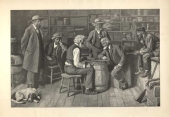The Checker Maven
The World's Most Widely Read Checkers and Draughts Publication
Bob Newell, Editor-in-Chief
Published every Saturday morning in Honolulu, Hawai`i
Noticing missing images? An explanation is here.
Uncle Ben's Porch: Back To School

When we last visited with Tommy on Uncle Ben's Porch, he was getting ready for the Varsity Checker Team tryouts, and even though he was quite young, was hopeful of winning a Varsity berth. Now, the new school year has started, and the tryouts were over. We rejoin Tommy on the first Saturday morning after the opening of school.

A very sad Tommy was sitting on Uncle Ben's porch this Saturday morning. "I didn't make it, Uncle Ben," he said in an almost despairing voice. "I didn't make the Varsity Checker Team. I got all the way through the tryouts and I was all set to make the final cut. Then Coach Hovmiller tested us on problems ... and ... and ..."
Tommy just couldn't continue.
"Let me guess, Tommy," said Uncle Ben in a kindly manner. You were able to solve the first few, but then you missed one that the coach thought a Varsity candidate should have solved."
Tommy was silent for a moment and then blurted out, "But I got the rest of them right! It isn't fair!"
"Fair, Tommy?" answered Uncle Ben. "How can it be unfair? All the students at the tryout had the same opportunity to solve the problem that you did."
"Only two boys and one girl got it right," said Tommy, "and they're a year older and...."
"And they got the Varsity slots," concluded Uncle Ben. "As is right and fair. But let's not cry over spilt milk! Next year you'll be a year older yourself, and you'll almost certainly make the Varsity. Meanwhile, this year, do your best on Junior Varsity. No doubt you'll be the top player and get selected Captain! But show me the problem that troubled you."
Tommy arranged the pieces on the board. "It's Black to win," he stated, "and I looked at it for a while and had an idea."
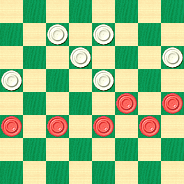
BLACK
Black to Play and Win
B:B6,9,11,12,14:W18,20,23,27,31.
"I thought 12-16 was the winning move, Uncle Ben, but then Coach Hovmiller played 27-24. I played 13-17 to prevent 26-22, meaning to follow-up with 10-15."
"Yes, Tommy," replied Uncle Ben, "but what was wrong with that idea?"
"Well, Coach Hovmiller played 24-19, squeezing my man on 16, and then I saw that 10-15 was impossible now! So I failed, Uncle Ben... I failed!" Tommy concluded, practically on the verge of tears.

Uncle Ben knew it was time to pour the lemonade. He waited while Tommy took a few comforting sips, and then said, "You didn't fail, Tommy, you just made a simple mistake while under pressure. Players both average and great have done that. And if you are honest with yourself, you'll know it means you need another year of play to really be ready for Varsity on a team as good as the one that plays for your school."
"Yes, sir, I know that," admitted Tommy at last, "but I do hope you aren't disappointed with me, and will still keep me on as your student."
"Oh, Tommy," cried Uncle Ben, "never fear! You are a talented youngster and I'm proud to have you as my student. Now, let's have another look at that position, and let's have you master it once and for all!"
Was that the trace of a smile starting to appear on Tommy's face? "You bet, Uncle Ben!" he said with genuine enthusiasm, and the two of them, the young student and the old master, bent over the board to study in earnest.
Would you have passed Coach Hovmiller's final test? Try out the problem for yourself, and then click on Read More for the solution, a sample game, and numerous additional examples of the same theme.![]()
Some Good Exercise
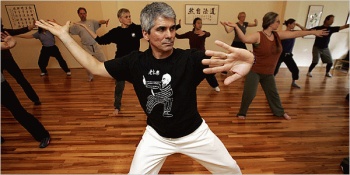
We all know that exercise is good for us, but that few of us do enough of it. What is true for the body, of course, is true for the mind, and today we challenge you to do some checker exercise. (We're tempted to call it "checkersize" but perhaps that's just a little over the edge.)
First take a look at the position below; it's one of those odd "White to Play, Black to Win" sort of things.
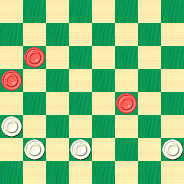
WHITE
White to Play, Black to Win
W:W28,26,25,21:B19,13,9.
What do you make of this? The exercise we invite you to try is to think about the possible White moves, Black replies, and ensuing lines of play. What gives White the best chances? How are those chances foiled by Black? Spend a little time on this and stretch your checker muscles; your technique and skill is bound to benefit. Then exercise your mouse finger by clicking on Read More to see our idea of the solution.![]()
The Paisley Pickle Barrel

With this entry in our very popular Tricks Traps & Shots of the Checkerboard reprint series, we're in a bit of a pickle ourselves, as the unthinkable has happened: from our computer analysis of the position presented by checker legend Willie Ryan, we've found that Mr. Ryan seems to have made a most untypical error. So our "pickle" is this: do we publish the correction, or simply give Mr. Ryan's position and analysis as originally published?
In the end, we decided to print the new analysis, as we're certain that Mr. Ryan would have always preferred to see the best moves brought forward.
So, first we'll listen to Willie explain the situation. Then, we'll see his analysis followed by what the computer has to say.
"On my road travels around the country, I am frequently asked, 'Mr. Ryan, with what particular play do you win most frequently in your exhibitions?' There is no doubt that my No. 1 haymaker is a nondescript concoction, which I have tabbed the Paisley Pickle Barrel, because I have pickled more plebes with it than you can shake a stick at. This is it: 11-16, 24-19, 8-11, 22-18, 10-14, 25-22, 16-20, 29-25---A and we reach the fateful fix shown on the diagram.
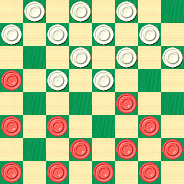
BLACK
Black to Play and Win(?)
B:W18,19,21,22,23,25,26,27,28,30,31,32:B1,2,3,4,5,6,7,9,11,12,14,20.
A---Natural, but probably a loss. 22-17 results in a draw, and so does 19-15, 4-8, 22-17, etc."
What do you make of this particular pickle? Think it over --- it's anything but easy --- and then click on Read More for some deep and fascinating insights.![]()
A Small Problem

In the winter scene depicted above, it seems that the owner of the car has "a small problem" to deal with. And, while the solution to such a problem is straightforward, the amount of effort involved looks to be considerable.
Checker problems, though, follow different definitions. "Small" checker problems generally deal with relatively few pieces; in today's offering, drawn from our Checker School series, there are but three pieces per side. The solution to "small" checker problems is not always, or even often, straightforward; and the amount of effort needed to find the solution is at times substantial.
Here's the situation we ask you to consider.
Black
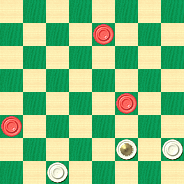
White
White to Play and Win
W:WK27,28,30:B7,19,21.
White is certainly better off, but is it enough to win? That's your little problem! Dig your way out and then click on Read More to see the solution, notes, and a sample game.![]()
Marvin's World

Marvin J. Mavin
Captain, Detroit Doublejumpers
The world of Marvin J. Mavin is featured often in the columns of The Checker Maven, and today, in this extra edition, we're providing you with all the details. How did it happen that (at least in Marvin's world) checkers became America's number one sport, eclipsing baseball and football by large margins?
At long last, you can read the full background story. Click on the link to find out about Marvin's World.![]()
An August Stroke

Early August certainly is thunderstorm season in the Santa Fe, New Mexico area, where one of our Checker Maven editorial offices is located, and strokes of the electrical variety are very common. But today we return to a different kind of stroke, that of the checker variety, and a complex problem that will either please or annoy depending on your skills and predilections. Here's the situation; you will need excellent visualization skills and a good imagination to sight-solve this one.
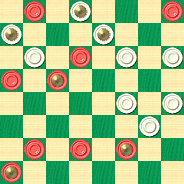
WHITE
White to Play and Win
W:WK2,K5,K7,9,11,12,19,20,24:B1,4,10,13,K14,25,26,K27,K29.
No doubt you will get a charge out of the solution, if you don't actually find it shocking; but we can, as always, state that it is safe to click on Read More to see the electrifying solution.![]()
You'll Get A Kick Out Of This
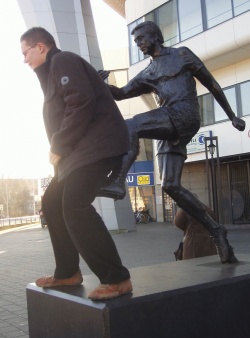
Today we are pleased to present another crowd-pleasing Tommie Wiswell composition. In Mr. Wiswell's own words, "You'll get a real 'kick' out of this one. The solution is short and snappy and the 'key' move is quite a shock --- to Black."
Here's the position, and we don't claim that it's an easy one.

WHITE
White to Play and Win
W:W14,17,22,23,28,31,32:B5,6,K8,13,20,K26.
White is a man up, but Black has two kings and threatens to even the material count. Can you find White's win, or will this problem kick your posterior? Give it a try but don't kick the bucket; instead, click on Read More to see the solution.![]()
The Steel Stroke

One thing Willie Ryan could do as well as any checkerist who ever lived was to tell an entertaining story. Here, in our monthly installment from his classic Tricks Traps & Shots of the Checkerboard, Willie relates a couple of anecdotes about a checker position that dates back over 200 years but still astounds us today.
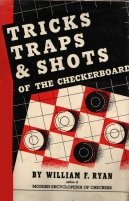
'Now we come to an old chestnut credited to James Steel, of Newcastle, England, identified as the Steel Stroke. When Joshua Sturges reached the diagrammed position below in his "Guide to Draughts" (1800), he overlooked the stroke, playing 17-21 to a draw instead! After the 1905 American-British International Checker Match, former World's Champion Robert Stewart, of Scotland, was persuaded by friends to play "Ajeeb," the automaton checker player, then on exhibit at the old Eden Musee in New York City.
When the position shown below was reached, Stewart moved 12-16 to start the shot. When the "figure" failed to respond, the attendant told Stewart he would have to move faster. Whereupon, Stewart informed the attendant it was Ajeeb's move. The attendant then pretended to wind up the figure, announcing that the game could not be finished because the main steel spring in the machine was out of order!
| 11-15 | 21-14 | 28-24 |
| 23-19 | 15-18 | 11-16 |
| 8-11 | 19-15 | 26-23 |
| 22-17 | 4- 8 | 16-20 |
| 9-13 | 24-19 | 31-26---B. |
| 17-14 | 13-17---A | See the |
| 10-17 | diagram. |
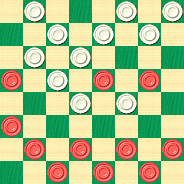
BLACK
Black to Play and Win
B:W32,30,29,27,26,25,24,23,19,15,14:B20,18,17,12,8,7,6,5,3,2,1.
A---White has a trap here, for if black moves 11-16, white will win with 26-22, 16-23, 15-10, 6-15, 25-21, 18-25, 27-4.
B---Right after Ajeeb made this move, he developed mechanical cramps. The proper play to draw is: 15-10, 6-15, 19-10, 17-22*, 25-21, 12-16*, 32-28, 16-19, 24-15, 22-25, 29-22, 18-25, 21-17, 7-11*, 30-21, 11-18, 23-19, 18-22*, 19-16, 2-7, 17-13, 22-25, 13-9, 25-30, 9-6, 5-9*, 14-5, 7-14, 27-24---1, 20-27, 31-24, 1-10, 5-1, 14-18*, 1-6, 10-14, 6-10, 18-22*, 10-26, 30-23, and black can draw with care---2. This fine play is by World Champion Walter Hellman.'
1---The King's Row computer program chooses 6-2 instead and finds what looks like an easier draw than Hellman's line with the calculated line of play being 6-2 30-25 27-23 25-22 23-19 14-18 16-12 8-11 19-15 11-16 28-24 20-27 31-24 16-19 24-20 19-24 20-16 18-23 16-11 23-26 15-10 26-31 2-6 and it's clearly a draw---Ed.
2---King's Row agrees that this position is a draw despite Black being a man down---Ed.
No need for you to have cramps or a broken spring over this one; unwind the tension by clicking on Read More to see the solution.![]()
Similar But Not Quite The Same
Can you find a total of eight differences in the two pictures above? It's a classic sort of puzzle, and unless you're rather skilled with images, finding the last little variation is often quite a challenge.
In today's edition of Checker School, we present two "similar but not quite the same" positions. The optical differences are a little easier to find than in our teaser above, but the over-the-board solutions may prove somewhat more resistant.
In both of today's positions, shown below, White is to play and win. We'll give you a small tip: one of the positions is quite a bit easier than the other, despite similar appearances. Not much of a tip, we agree, but we are known to be notably stingy in the hint department.
| B. OLDMAN | A. SCHAEFER |
| BLACK | BLACK |
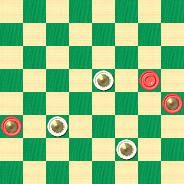 | 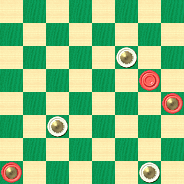 |
| WHITE | WHITE |
| White to Play and Win | White to Play and Win |
| W:WK15,K22,K27:B16,K20,K21. | W:WK11,K22,K32:B16,K20,K29. |
Make a difference and find the solutions; but if you can't tell the difference, it will make no difference if you click on Read More to see the answers along with a sample game and detailed commentary. And, for extra non-checker related credit, identify the U.S. destination known as "The City Different."![]()
Fourth of July Picnic
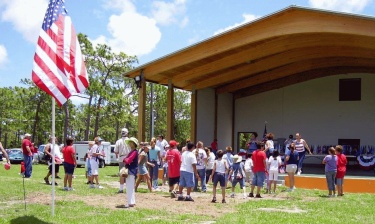
Tommy always looked forward to going to the Fourth of July Picnic with his family. There would be hot dogs, hamburgers, watermelon, ice cream cones, and a host of summer treats. There was the three-legged race, the pie-eating contest, and more fun than could ever be imagined, topped off with an exciting display of fireworks. Tommy's home town in Florida really knew how to celebrate America's birthday.
But this year was even more special. Tommy was going to play in the adult section of the Fourth of July checker tournament! Normally, he would play in the elementary school section, but this year he had managed to get permission to go straight to the top and play with the grownups.

Now, Tommy had been studying checkers every Saturday morning with Uncle Ben (see our Uncle Ben's Porch series of columns). Uncle Ben wasn't really his uncle, but everyone called him that; and under his mentoring, Tommy had come a long way with his checker skills.
Uncle Ben was at the picnic, of course, but as a full-fledged professional wasn't allowed to enter the tournament. Tommy wanted to make him proud and was determined to play well. But playing against experienced adult checkerists was no easy assignment.
The tournament was "single life" elimination. If you lost your round, or if your game was a draw in two rounds, you were out of the competition.
The first round was about to begin. Tommy was paired with a very tough opponent, 47-year old insurance agent Bob Fernastus, one of the top adult amateurs in the area. Bob was captain of the county champion recreational checker team, the Mutual Farm Draughts Oxen.

Bob Fernastus
They met at their assigned board. "Pleased to meet you, Mr. Fernastus," said Tommy politely as they shook hands. "Same here, young man," said Bob in return; was he perhaps being just a bit condescending to his much younger opponent? But just at that moment, the tournament director gave the call, "Start your clocks!" and the tournament was underway.
Tommy had White and the game unfolded as follows.
| Black: | Bob Fernastus | |
| White: | Tommy | |
| 1. | 12-16 | 22-18 |
| 2. | 8-12 | 25-22 |
| 3. | 16-20 | 24-19 |
| 4. | 4-8 | 22-17 |
| 5. | 9-13 | 30-25 |
| 6. | 13x22 | 26x17 |
| 7. | 10-14 | 17x10 |
| 8. | 7x14 | 18x9 |
| 9. | 5x14 | 25-22 |
| 10. | 6-10 | 22-18 |
| 11. | 1-5 | 18x9 |
| 12. | 5x14 | 29-25 |
| 13. | 11-15 | 25-22 |
| 14. | 15x24 | 28x19 |
| 15. | 3-7 | 32-28 |
| 16. | 2-6 (see diagram) | 28-24 |
| 17. | 8-11 | 22-18 |
| 18. | 6-9 | 18-15 |
| 19. | 11x18 | 21-17 |
| 20. | 14x21 | 23x5 |
| 21. | 7-11 | 27-23 |
| 22. | 20x27 | 31x24 |
| 23. | 21-25 | 5-1 |
| 24. | 11-15 | 1-6 |
Draw Agreed.
"Wow," said Bob, you really had me going there! Great game, Tommy, but do you realize you missed a win at move 16?"
Tommy, pleased to get a draw against a highly skilled adult player, looked puzzled. "A win, Mr. Fernastus? Really?"
"Yes, Tommy, you could have won the game! Do you want me to show you?"
"Yes, sir, if you would ... I had no idea ...."
"Well, then Tommy," Bob continued, "Here it is."
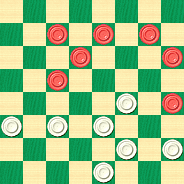
WHITE
White to Play and Win
W:W31,28,27,23,22,21,19:B20,14,12,10,8,7,6.
Could you have found the win where Tommy didn't? We'll warn you, it's subtle and probably well beyond the skills of even a very talented grade schooler. Give it a try and click on Read More when you're ready to see the solution and complete game notes.![]()
The Checker Maven is produced at editorial offices in Honolulu, Hawai`i, as a completely non-commercial public service from which no profit is obtained or sought. Original material is Copyright © 2004-2025 Avi Gobbler Publishing. Other material is public domain, as attributed, or licensed under Creative Commons. Information presented on this site is offered as-is, at no cost, and bears no express or implied warranty as to accuracy or usability. You agree that you use such information entirely at your own risk. No liabilities of any kind under any legal theory whatsoever are accepted. The Checker Maven is dedicated to the memory of Mr. Bob Newell, Sr.


